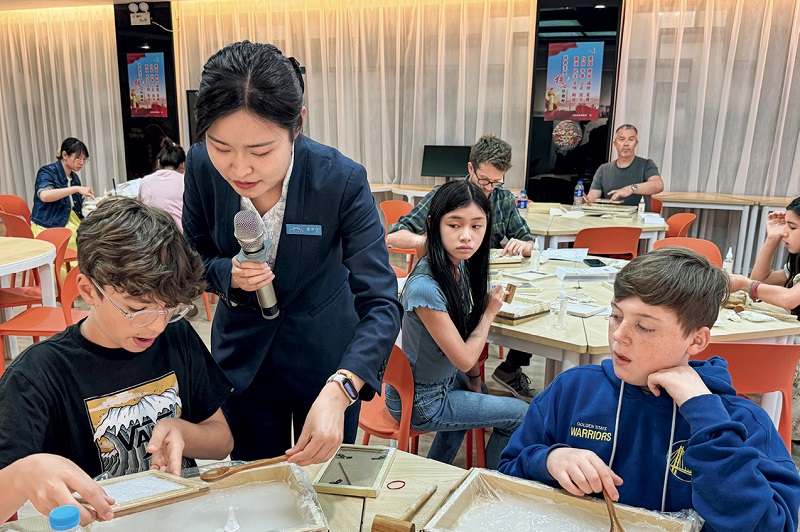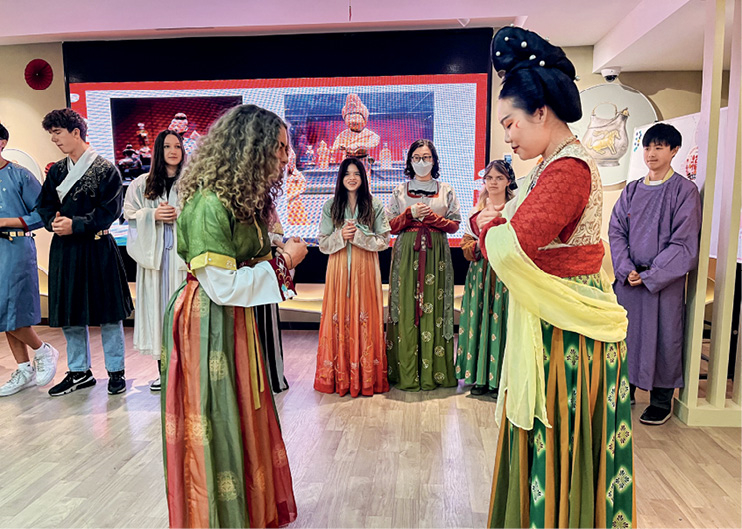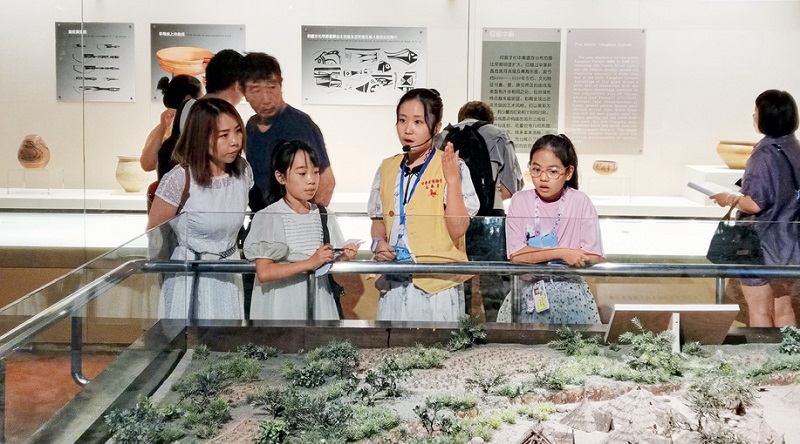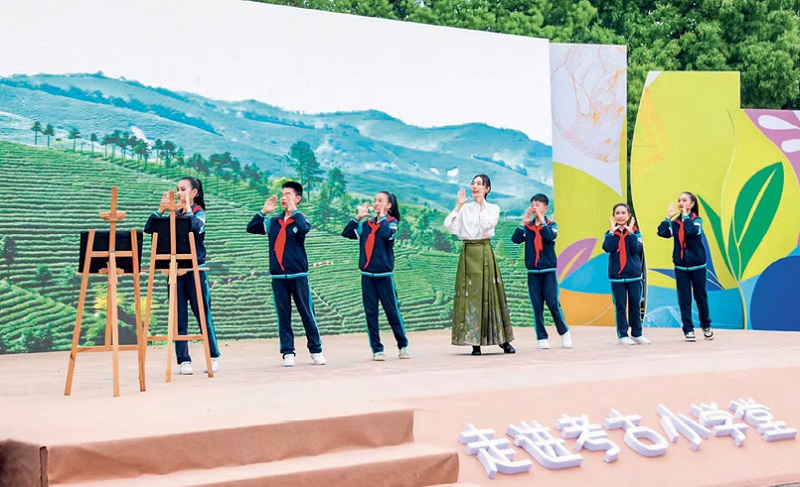In recent years, a new trend has emerged where an interest in museums and archaeology has hooked young people, allowing them to appreciate China’s rich history and be culturally enlightened, while simultaneously contributing to the spread of Chinese culture.

Teachers and students from the French American International School make paper in the ancient Chinese way at the Shaanxi History Museum.
Becoming a volunteer at museums, exploring ancient civilizations in archaeology classes at school, and engaging in cultural exchanges are part of a new trend young people are being drawn to. The rise in the popularity of museums is making children appreciate their country’s rich history and contribute to the spread of Chinese culture.

Teachers and students from the French American International School participate in a Tang-themed study tour at the Shaanxi History Museum.
Young Cultural Envoys
“When our ancestors made painted pottery, they outlined the shape of the giant salamander on it. They not only depicted the body of the salamander with a few strokes, but also used their fertile imagination to draw the exaggerated expression of the creature,” said Liu Chenrui, a 12-year-old volunteer in a yellow waistcoat at the Gansu Provincial Museum in Lanzhou City. Liu was describing a painted bottle with a giant salamander design, recognized as a national treasure. She spoke to a crowd of visitors during the May Day holiday, telling the stories behind the artifact and captivating her audience, who hung on every word.
“There are many young volunteers like her in the provincial museum; it’s great!” was a frequently heard compliment. Liu appreciates the praise. The dream of being involved with the museum started when she visited the National Natural History Museum of China in Beijing with her mother at the age of four. “That day, our guide was a little boy in the fifth or sixth grade. His extensive knowledge, professional explanation, and patience deeply attracted me, and I followed his tour for the whole morning without feeling tired.” It sowed a seed of love for museums and archaeology in her heart that is still growing.
In 2023, after learning about the online recruitment of volunteers by the Gansu Provincial Museum, Liu signed up and began her journey to become a volunteer. The selection involved fierce competition. From online registration to passing the interview, and then to attending training, it was not an easy process.
“The content of the training was quite difficult for me since I had never been exposed to archaeology, but the volunteer teachers at the Gansu Provincial Museum were very enthusiastic and patient in explaining and giving examples, which helped me gradually understand,” said Liu. After passing the volunteer’s exam, she still had to complete a number of volunteering hours within a set time. With firm determination and encouragement from her mother, Liu passed the final assessment, and was finally able to wear the coveted “yellow waistcoat” of volunteers.
Now, after providing volunteer services countless times, Liu deeply appreciates the significance of spreading Gansu’s culture and history through public activities and becoming a cultural ambassador. She has noticed that more and more foreign tourists are coming to the museum to learn about Chinese culture. They listen attentively to the explanations, take photos, and have discussions. Their interest in asking questions about things they do not understand always leaves a deep impression on Liu.
“I answer what I can in English, which also helps foreign tourists understand more about Chinese culture.” Through her work as a cultural ambassador, Liu has also become more determined to “be a good Chinese child, tell China’s stories well, and convey China’s voice.”
At the Gansu Provincial Museum, there are many young volunteers like Liu. They have become a signature feature of the museum, as well as little ambassadors spreading Chinese culture, thus contributing to cultural inheritance.

Liu Chenrui, a volunteer at the Gansu Provincial Museum, tells young visitors about the museum’s painted pottery exhibition.
Archaeology’s Rising Popularity in Schools
“How did humans evolve?” “What does a stone tool signify?” “What does a symbol represent?” In April this year, the launching ceremony of the “Little Archaeology Classroom” and the Route for Anji Archaeology Study Tour was held at Xilong Elementary School in Anji County, Huzhou City of Zhejiang Province. Xu Xinmin, a researcher with the Zhejiang Provincial Institute of Cultural Relics and Archaeology, delivered an inspiring lecture titled “Where Do I Come From?” which guided children through a journey of millions of years to explore the mystery of human origin.
Shi Zhengxuan, a sixth grader at Xilong Elementary School, listened with great interest. “I learned many stories about the Shangmakan Paleolithic Site and the origins of humans.” What made her even happier was that the Paleolithic Archaeology Picture Book, which she had helped make, was released at this event. In the book, Shi and her classmates used vivid lines and vibrant colors to depict their understanding of ancient times and archaeology. Regarding the future activities of the Little Archaeology Classroom, Shi said that she hopes to learn more about Chinese history and cultural relics through it.
Zhang Bo, deputy principal of Xilong Elementary School, said, “The school set up the Little Archaeology Classroom to let students personally experience the mystery of archaeological surveys and the sense of achievement in discovering relics, thus fostering their interest in history and archaeology.” The school also offers archaeological study tours where students can observe archaeological work up close and participate in field archaeology, “experiencing joy beyond textbooks.”
According to the head of the Zhejiang Provincial Institute of Cultural Relics and Archaeology, the first batch of Little Archaeology Classrooms has 11 schools in 11 cities in Zhejiang. These classrooms will facilitate resource sharing among schools, collaboration on class design, and joint reading activities, promoting common growth and progress. A team of 22 experts has been selected to mentor the classroom. In addition, a series of archaeological micro lectures will be launched on new media platforms and the first inter-school alliance of the Little Archaeology Classroom in Zhejiang established.
In recent years, activities that bring archaeology into the classrooms of elementary schools have become increasingly common. The “Hunan Archaeology in Campus” activity organized by the Hunan Provincial Institute of Cultural Relics and Archaeology entered Yuying Elementary School in Changde City, opening the door to archaeology for the children. The third round of public lectures on archaeology in elementary and middle schools in Anhui Province, themed “Discover Glorious History and Inherit Brilliant Civilization,” kicked off at Tunxi Road Elementary School in Hefei City. It helped young people understand Anhui’s long and splendid history through local archaeological discoveries and research. Shaanxi History Museum’s public lecture themed “Talking about the Tang Dynasty” was introduced in Dongcheng No.3 Elementary School in Baqiao District, Xi’an City, bringing an engaging and interesting history and culture lesson to over 200 faculty members and students. These activities not only enrich students’ extracurricular lives but also open a window to understand history, allowing young people to feel the charm of historical relics in a relaxed and pleasant atmosphere, and enhancing their sense of identity and pride in Chinese history and culture.
After attending the launching ceremony of the Little Archaeology Classroom, Shi Zhengxuan hopes that she can participate in archaeological work in the future and discover and promote ancient Chinese cultural heritage.

At the launch of the Little Archaeology Classroom, teachers and students from Xilong Elementary School give a performance.
Platform for International Cultural Exchanges
On May 18, 2024, the main event of the 2024 International Museum Day was held at the Shaanxi History Museum’s Qin Han Museum. As an important cultural landmark at the starting point of the Silk Road, the Qin Han Museum is expected to become a shining model along the Belt and Road. On the 2024 International Museum Day, young volunteers from the Shaanxi History Museum presented the brilliant achievements of the Qin and Han civilizations, with the key artifacts displayed in the “Great Unity under Heaven” exhibition hall. Among them, Fan Xiaoyi, a student from Houzaimen Elementary School, attracted many foreign tourists with her introduction of a lacquered wooden pig from the pre-Qin period (before 221 BC). It was a touching picture of cultural exchange and mutual learning between China and other countries.
The Shaanxi History Museum has always been committed to spreading culture and fostering friendship between young Chinese and their foreign peers, and has become an important platform for cultural exchange and inheritance of cultural heritage.
At the museum, the faculty and students from the senior high school of the French American International School in San Francisco journeyed back in time wearing face ornaments and learning Tang Dynasty (618-907) etiquette. In this way they became expats living in Chang’an, one of the two capitals of the Tang Dynasty, during a Tang-themed study tour organized by the museum on the occasion of the traditional Qingming Festival.
The faculty and students from the junior high school of the same school participated in an educational activity, making paper the ancient Chinese way. They not only gained an understanding of the profound traditional Chinese culture by observing valuable historical relics, but also made exquisite floral paper frames with their own hands, experiencing the joy of labor and creation.
Such activities allow non-Chinese youngsters to understand China’s fine traditional culture. Carefully designed interactive sessions enrich their learning experience and are a new attempt at international communication in museum education. The Shaanxi History Museum plans to strengthen the development of cross-cultural exchange and education activities, launch more high-quality educational programs, and continue to carry forward cultural heritage.